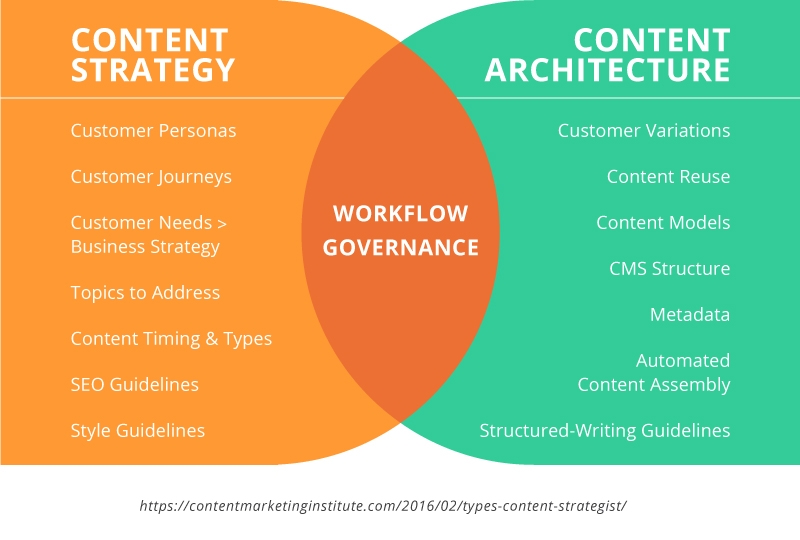How smarter content architecture drives business transformation

Successful businesses have always set themselves apart by their ability to deliver valuable content to consumers. While that still holds true today, content delivery and consumers themselves have changed drastically in the last decade. No matter how great the content, serving the same thing on a single channel isn’t going to cut it anymore. Now, the “when,” “where,” and “why” of content delivery is just as important as the “what.”
How can today’s enterprise organizations keep up with competitors when the rules seem to change with more and more regularity? With smart content architecture that empowers companies to deliver personal, scalable, and beautiful content on every single channel and device.
The following looks at the ins and outs of smart content architecture, its big business benefits for enterprise organizations, and the one tool you should keep in your roster to harness its transformative power—no matter how the rules change.
What is content architecture?
Chances are you’ve heard of information architecture, but what about its close, yet lesser-known, relative—content architecture?
Veteran content strategist Shelly Bowen provides great definitions of each and a helpful example that explain the nuances of their relationship.
Information architecture is the process of organizing and labeling content, so it’s findable and usable.
Imagine you have a store full of random sports-related equipment (aka, content) like bikes, basketballs, air pumps, bike seats, and more. An information architect will label each of these items and find a way to organize them so that they’re easy for shoppers and clerks to find and use no matter how they search—by sport, brand, part number, etc.
Next comes content architecture (or “content delivery network” architecture), which is the organization and labeling of each element that makes up the content. When it’s done smartly, content architecture ensures that these elements are searchable, useful, and, best of all, reusable.
Back in the sports store, a content architect will dig into the elements that make up each piece of equipment (again representing the content) and label them so that they can be displayed in different configurations. For example, a bike would be broken down into parts including tires, a seat, a frame, etc. When done correctly, smart content architecture labels each of these pieces so that shoppers and clerks can find the whole bike, a specific bike part, or both depending on their needs.
While content strategy typically focuses on the front-end customer experience and the content itself, content architecture looks at back-end content structure, scalability, and the technology that facilitates it.
The components of content architecture
Content architecture executes upon the strategy developed during the information architecture stage. Content architects typically employ workflows, content models, and wireframes when designing solutions that will lead to the eventual creation, management, and distribution of content.
Workflows
Content architect practitioners define how content flows from production to promotion. And when defining these workflows, they’re careful to consider everyone who needs to interact with the content, which may include writers, editors, management personnel and other stakeholders, and, of course, consumers!
Having a map of the overall flow of content as well as governance around each piece is also critical to evolving and improving content processes.
Content modeling
Content modeling documents all the types of content needed to effectively configure your content management system (CMS) for different channels and devices. It empowers you to future-proof both your content and your technology by separating content planning from the formatting and programming of the content.*
A content model is made up of detailed definitions of each type of content (blog, web page, draft, etc.), the components that make up each of these content types (fields like H1, meta description, body text, etc.), and the relationship (hierarchy, internal linking, etc.) between all the different content types.
The practice of content modeling brings together design, development, and content creation folks to make sure that end consumers get the content they’re looking for when they’re looking for it—and that internal stakeholders who work with the content can find, optimize, rearrange, and reuse it.
Wireframing
Wireframing refers to the process of “visually stripping the product down and allowing all involved to focus purely on functions and user interactivity.”
A wireframe can be thought of as an overarching blueprint that displays the relationship between all the content models you’ve created. Whereas a content model is meant to be reused for any display format, a wireframe is typically built with a specific format in mind such as web, app, smartwatch, etc.
Whether sketched on paper or drafted in special wireframing software, wireframes are essential for visualizing content architecture and inspiring early-stage collaboration between content managers, designers, developers, and stakeholders.
The business benefits of smart content architecture
“If I scale my content delivery, I’ll lose my ability to personalize it!”
“How can I effectively repurpose all my legacy content on new digital channels?”
Smart content architecture turns these and other common content concerns into big benefits for digitally-transformed businesses.
How to take advantage of smart content architecture and transform your business
The enterprise business world has transformed.
It used to be typical to deliver carefully-crafted content to a single channel. You were ahead of the curve if you were serving content—even the same content—to just a few different channels. But now, that carefully-crafted content has to be personalized, maintained, and delivered around the clock on a vast variety of channels and devices. Now, content lives on wearables, connected home devices, mobile apps, jumbotrons, voice-assisted devices, in-store kiosks, and more by the day.
The great news is, you can transform your business content to stay current and competitive. Part of that transformation will come from adopting scalable, smart content architecture. The other part will result from a content management system that can put all that smart content architecture to work. Luckily, that’s what a headless CMS like Contentstack does.
Contentstack CMS empowers enterprise organizations to create valuable content once and publish it everywhere, all the time.
Contentstack pioneered the concept of headless CMS—which is a content management system with no built-in front-end platform to determine how or where content is displayed. Instead, it allows front-end developers the freedom to build the best interface and use an API to call up the content. This is what keeps companies relevant in an omnichannel world where they need to serve consistent content everywhere from websites to apps, kiosks, chatbots, smartwatches, connected home devices, voice assistants, and much more.
For content managers, Contentstack makes it easy to create content models, workflows, labels, and other key features that make up smart content architecture. Contentstack lets you easily integrate the best of breed personalization engine to help you segment and optimize your content while built-in AI-enabled widgets can analyze content to improve performance and SEO.
Contentstack takes care of enterprise business users with platform-agnostic marketing, ecommerce, and analytics integrations. Developers will be happy to know that we provide the enterprise-level availability, security, and scalability that your IT stack requires.
if you’re ready to finally take advantage of smart content architecture and transform your business today, give Contentstack a test drive and build out a (free!) proof of concept today.
About Contentstack
The Contentstack team comprises highly skilled professionals specializing in product marketing, customer acquisition and retention, and digital marketing strategy. With extensive experience holding senior positions at renowned technology companies across Fortune 500, mid-size, and start-up sectors, our team offers impactful solutions based on diverse backgrounds and extensive industry knowledge.
Contentstack is on a mission to deliver the world’s best digital experiences through a fusion of cutting-edge content management, customer data, personalization, and AI technology. Iconic brands, such as AirFrance KLM, ASICS, Burberry, Mattel, Mitsubishi, and Walmart, depend on the platform to rise above the noise in today's crowded digital markets and gain their competitive edge.
In January 2025, Contentstack proudly secured its first-ever position as a Visionary in the 2025 Gartner® Magic Quadrant™ for Digital Experience Platforms (DXP). Further solidifying its prominent standing, Contentstack was recognized as a Leader in the Forrester Research, Inc. March 2025 report, “The Forrester Wave™: Content Management Systems (CMS), Q1 2025.” Contentstack was the only pure headless provider named as a Leader in the report, which evaluated 13 top CMS providers on 19 criteria for current offering and strategy.
Follow Contentstack on LinkedIn.




.svg?format=pjpg&auto=webp)
.svg?format=pjpg&auto=webp)
.png?format=pjpg&auto=webp)






.png?format=pjpg&auto=webp)




